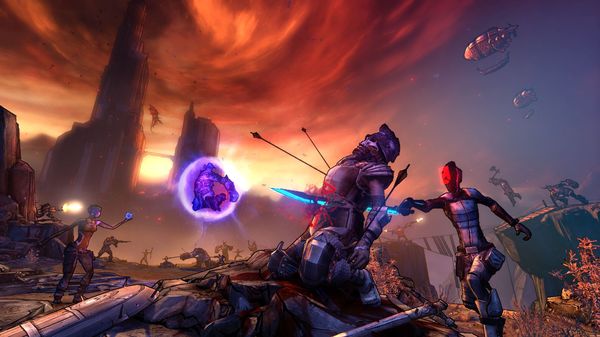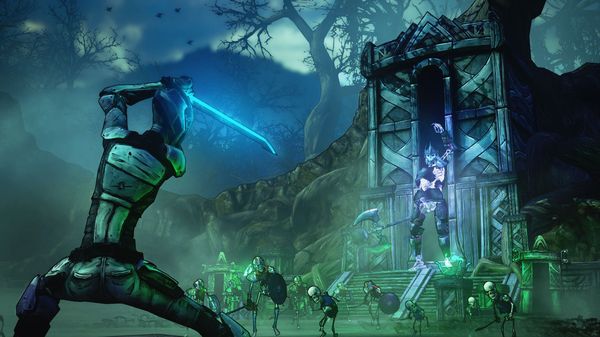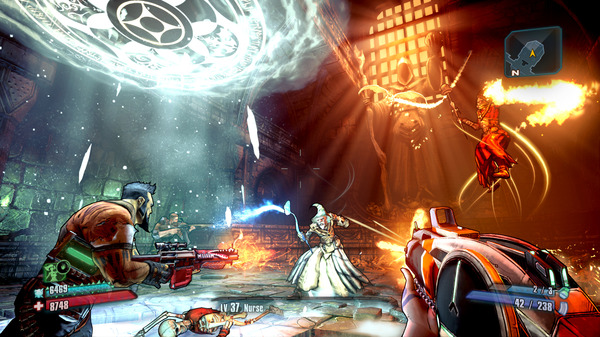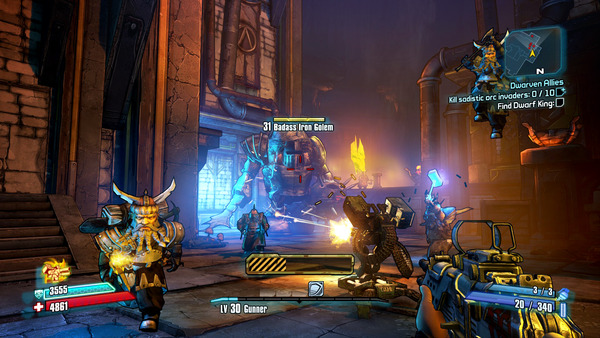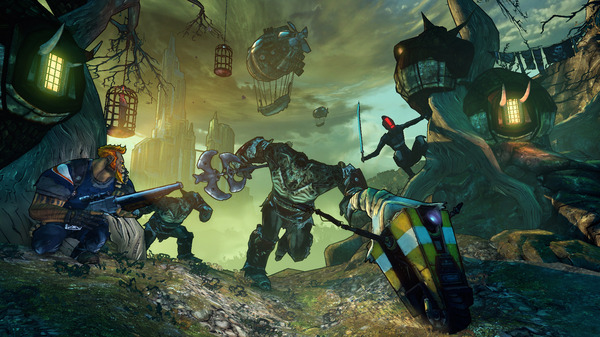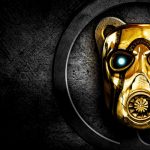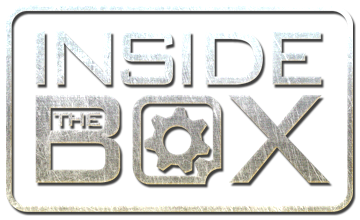
Inside the Box serves as a forum for individuals involved in the production of Gearbox Software content to share personal motives, methods, process and results. Gearbox Software projects are created by a diverse range of individuals spanning a spectrum of different backgrounds, interests, objectives and world views. The views and opinions expressed in this article are those of the author and do not necessarily reflect the official policy or position of Gearbox Software or any of its individual members outside of the author.
I’m Ryan Heaton, the Lead Level Designer for Tiny Tina’s Assault on Dragon Keep, and I’m here onInside the Box to give you an inside look into our high level design goals and development process for project Aster (the internal codename for Dragon Keep) which launches tomorrow, June 25.
Dragon Keep is a massive downloadable campaign add-on for Borderlands 2 that we completed on a very tight schedule. We started out talking about what we expected from the project and what our fans expected. We were fortunate enough to have a very large and talented team dedicated to Dragon Keep, so we all agreed that this has to be a big add-on. We talked a lot about how great the “General Knoxx” add-on was for the original Borderlands and wanted to create something of that magnitude. And since Dragon Keep is the last campaign add-on in the Borderlands 2 Season Pass, we wanted to make sure to go out with a bang and really reward our fans for sticking with us. Aster would turn out to be the biggest DLC yet. Our core team of leads included myself, Carl Shedd (Visual Design Lead), Matt Charles (Lead Producer), Tris Baybayan (Art Lead), Anthony Burch (Writer), Ruben Cabrera (Enemy Design Lead), Skyler Jermyn (Mission Lead), Trey Davenport (Animation Lead), Jim Sanders (FX Lead), Joshua Davidson and Raison Varner (Audio Leads), Chris Pickett (Programming Lead) and Andrew Hoffman (QA Lead).
WARNING: THE EVENTS OF BORDERLANDS 2 ARE DISCUSSED BELOW
Premise
First, the team got together and brainstormed about the premise of what we wanted to do. The fantasy idea was there from the beginning, it was something all of us really wanted to work on. Initially, there was the idea that Handsome Jack had a spoiled nephew that lived on an island and would trap the Vault Hunters in a game that forced them to fight their way through a series of complex challenges he had designed. This idea was folded into the fantasy idea, and eventually Tiny Tina became the dungeon master. We also talked a lot about fairy tales as a theme and their relationship to fantasy. An interesting note: of all the various ideas we talked about, the theme of heavy metal rock and roll was near the top of the list — in hindsight, I’m really glad we did not go in that direction.
We locked in on the idea of Tina as dungeon master in a completely imaginary place. Dragon Keep is a fictional universe within a fictional universe, a game within a game. Since the campaign takes place in this context, this allows us to go where few developers have gone before. Often one of the biggest constraints as a designer is ensuring your ideas make sense in the game world. Your idea, no matter how cool or interesting, has to exist logically within the game world. However in Tina’s imagination, anything can happen. This allows us to go completely off the rails, things that normally wouldn’t make sense are fair game. We can break the 4th wall anytime we want and still have it “make sense.” For example, shredding ancient skeleton warriors with a futuristic assault rifle is not something you normally see. Or having the entire sky change instantly from sunny rainbows to dark foreboding storm clouds. Things in this world can change as fast as Tina can think of them. Our Mission Lead Skyler went out of his way to sell these moments with special effects and dialog written by Anthony. Every time Tina changes the game, it’s in a meaningful way that is backed up by visuals and sound.
Size and Scope
Going into this, we knew that if we wanted to sell the fantasy world we would have to double down on environments, enemies, and characters. From week one, we knew we couldn’t just re-skin a bandit or put a hat on him.
Carl and Tris led the effort to build completely new environments. The artists created entirely new and complete art sets full of different types of objects that were created specifically for a particular map’s theme. Among the new art there is a castle set with a metallic Hyperion look, a dungeon set, dwarf architecture, and ancient ruins set made of stone, and other materials and structure types that we did not have in the regular game. Because we focused so much of our effort into specific map themes, the new environments achieved a very high level of visual quality and cohesion. The end result is much more than a simple Borderlands re-skin, it’s a new fantasy Borderlands game.
We were successful in our goal to have the environments tell a story all while the player’s final destination looms in the background. We wanted that classic fantasy feeling of the dark castle on the horizon, a fairy tale journey of the player’s struggle to reach the peak of the castle. You can feel from the very start exactly where you need to go. See that tiny bridge in the distance between the towers? Yeah, it’s actually a gigantic bridge and a major encounter happens there, pretty cool. The vistas in Dragon Keep are some of my favorites in all of Borderlands, Carl really has an eye for these types of things.
Promise of Quality
Week one, when we listed all the new enemies on the white board, the producers (holders of the schedule) were already freaking out because we were already over-scoped. But it was okay, because the core team wanted to make a statement with this add-on, not because we had to or because we wanted profits, but because we wanted to deliver for our fans. And once you decide to make a complete fantasy world and all that entails inside a game that is not fantasy, you are over-scoped from that very instant. So when it ended up coming down to how much the team liked working on this project, everyone stepped it up.
New Enemies
Moving on to talk about enemies, we have a mad scientist over here named Ruben. He led the effort creating all the new enemies. We knew that we had to do all new enemies to complete the fantasy experience. We originally specified around 4 variants per new enemy type, with around 11 new enemy types. So Ruben starts working on the skeletons first, I ask him how it’s going and he tells me, “dude I love skeletons”. I reply, “yeah… skeletons are cool.” Then Ruben wants to be clear, “no dude, you don’t understand, I REALLY love skeletons.”
A couple weeks later, we have 16 variants of skeletons alone. Remember initially we planned on 4. We have a chubby variant skeleton, why? I have no idea. We actually had so many new enemies, we had to be very careful and deliberate in how we placed them else we risked running out of memory. The great thing about that “problem” is that helped us make sure each map had a very unique feel to it both visually and with game play.
With the new enemies being different body types from our standard bandit, our Animation Lead Trey wanted to really push the boundaries for his guys. The animation schedule was very ambitious to meet the demands of so many new enemies. Some enemies, like the Orc, didn’t come completely online until the very last weeks. Amazingly our guys had become such a well-oiled machine from Borderlands 2 and other projects that the Orcs turned out looking and animating beautifully. Adam May modeled the Orc, probably our best looking enemy in the campaign and a fresh take on an old fantasy trope.
Oh, and I can’t forget one of my favorite things: boss fights! This was a personal goal for me, I love me some boss fights. I tend to favor a certain style of game that includes lots of bosses and steep challenges. (A trivia bonus point for you if you can guess the game.) So I said, hey why don’t we just have a boss fight at the end of every map? The scope of this was scary, but I felt it was worth the stretch. I really feel it makes the finale of a map much more satisfying and gives a sense of achievement for the player. It’s all about escalation of challenge and telling a story about that particular area. The bosses turned out great, each themed for their area.
Complete Borderlands Experience
For this campaign we wanted a complete and polished experience. More than a simple add-on, we wanted this to feel like a triple-A game of the same quality of the main game. To accomplish this we decided to leave nothing untouched. All of the small details, new vending machines, slot machines, weapons, gear. We decided to add a new Raid Boss and a new Temple of Slaughter challenge using all of our many new enemies. Jason Reiss was dedicated solely to the Slaughter making it a major piece of new game play and content.
The story narrative and dialog are written by Anthony. The humor is spot on and delivers the Borderlands style dialog that we all love. When we started out we talked a lot about the story of Borderlands 2 and how our fans wanted to find out more about the main characters and even some of the side characters. One of our narrative goals was to somehow tie this new story to the story in the main game, something that had a meaningful connection to our favorite characters. We talked about Dragon Keep being Tina’s retelling of the events of Borderlands 2, how she interpreted the story. Some of those ideas were retained in the final plot flow. Even though we were making this crazy fantasy game which is all about fun and breaking the 4th wall, we wanted to find a way to have a serious meaningful narrative arc playing out in the background. Anthony did a great job accomplishing this by bringing in the very sensitive subject of Roland and Bloodwing’s death in the main game (you can learn a bit more about this in his Inside the Box article, Fart Jokes and Tragedy). We know those are big moments in Borderlands history and Dragon Keep’s narrative delves into how this affected Tiny Tina. I’ll stop here before I spoil the plot for you because you should really play it for yourself. You may even cry.
Missions and side missions in Dragon’s Keep are fully realized with the same attention to detail as the main game. Skyler doubled down on the main plot flow and gave the missions that extra level of polish that goes beyond what you’d expect from downloadable conetnt. Special effects like the trees wilting and the time of day changing dynamically really helped sell these important plot moments when Tina changes the game world. We leaned on Jim and the FX department to help us make these moments feel fully integrated into the experience. The music in Dragon Keep is amazing, Raison and Jesper Kyd did a great job giving all the different maps atmosphere. In early focus testing we got a lot of positive feedback about the music and it is very different from the main game to match the fantasy setting.
Development Schedule
Last but not least is one of the most important goals in all of development, the schedule. Sixteen weeks. For development time on a triple-A product this is nothing, so you might be wondering how this is possible. The answer is a combination of many things which are somewhat rare. Experience is a major factor. The team at Gearbox has become very skilled at delivering solid Borderlands content. The other two things we had going for us was very high levels of communication among the leadership and the team. Matt, our producer, did an amazing job of managing the risk of growing scope. Everything and everyone just clicked, plus everyone on the team loved working on the fantasy content. It’s so different than what we typically do, but at the same time universally understandable and relatable. Week one, we knew (or at least some of us knew) that we were over-scoped for the schedule. Now this could be construed as irresponsible for the team leadership, but it’s not. The reason is the promise of quality as I mentioned above.
I really believe this add-on is exactly what it needed to be. We saw this as an opportunity to really knock it out of the park. The team went out of its way to make a game that was bigger than the schedule allowed. So in the end if you have a team that absolutely loves what it’s doing, combine that with good leadership, and the impossible becomes possible.
And there you have it, an inside look into Tiny Tina’s Assault on Dragon Keep. Thanks for reading!
If you have any feedback on this articles or what you want to see here on Inside the Box in the future, please let us know at [email protected] or hit up our forums.


